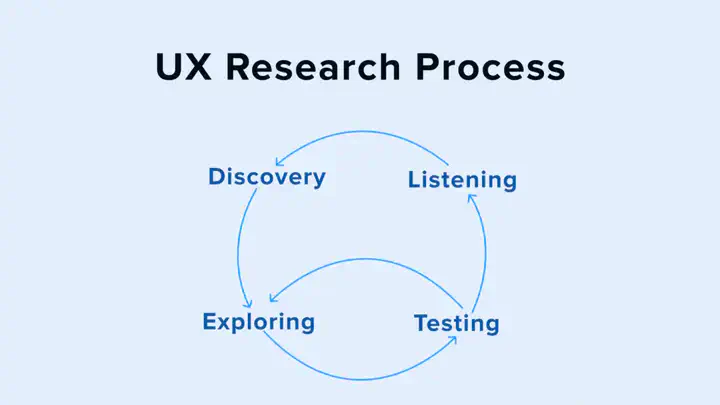The 4 stages of any UX research process

Abstract
Without a clear understanding of why you are conducting UX research, you run the risk of collecting irrelevant or inconclusive data, which can lead to wasted time, effort, and resources.
0. Find the WHY of my research
Without a clear understanding of why you are conducting UX research, you run the risk of collecting irrelevant or inconclusive data, which can lead to wasted time, effort, and resources.
To find the “why” behind my UX research, I ask myself:
- What do I want to know? This is the core question, and will be further refined into specific, actionable, and practical research questions.
- What don’t I know? Identify knowledge gaps and limitations early, so you can aim to correct for them.
- How will I know when I’ve learned it? What must be true in order for this research to be considered “done”?
- What company goals will this work support? It’s always a good idea to be familiar with your organization’s business model and key performance metrics.
- Where am I in the product development process? Your research goals will look different depending on whether you’re in the discovery, validation and testing, launch, or ongoing listening phase.
- What decision will this research enable? How will stakeholders act on the information you learn through your research?
- What are the anticipated outcomes of this research? What would success look like for you?
By answering these questions, I can establish a clear research objective that will guide my entire research process.
Now, a question for you: did you know the UXR process can be broken down into four distinct stages?
What are the 4 stages of the UX Research Process?
It’s worth noting that the UX research process isn’t always a linear journey. In fact, it often feels more like a loop, where you discover, define, design, and rerun the process one more time.
But by breaking the process down into these four stages, you can ensure that you’re gathering the right insights at the right time and creating a user-centered product that meets your users’ needs.
1. Discovery Phase in the UXR Process
The first stage of the UX research process is the discovery phase. In this phase, you’re trying to gain a broad understanding of your users and their needs. This might involve conducting user interviews, analyzing user data, or performing competitive research to see how other apps or products are solving similar problems.
Here is how my discovery stage look like:
- Ask the Experts. Learn from others’ successes and mistakes.» I learned how to conduct experts interview from AJ&Smart.
- Follow ethical guidelines. The UXPA Code of Professional Conduct is a good starting point.
- Involve stakeholders. I don’t just ask for opinions; I get people onboard and contribute, even in small ways.» Share my findings, invite them to observe and take notes during research sessions, or educate them on the new insights and findings.
- Hunt for data sources. Who has the information I need, and how can I gather it?
- Determine UX metrics. Find the right metrics to measure how well the system is working for its users.
2. Exploring Phase in UXR Process
One of the great things about the exploration phase is that it overlaps with your active phase in the design process. Whenever you need to validate your design assumptions, you can use one of the exploring methods to gather feedback and insights from your users.
Here is what I do in the exploring phase:
- Use evidence-based design guidelines, especially when I can’t conduct my research due to budget or time. Usability heuristics are high-level principles to follow.
- Design for universal access. Accessibility can’t be tacked onto the end or tested in during QA. Access is becoming a legal imperative, and expert help is available. Accessibility improvements make systems easier for everyone.
- Check for surprises. See if my product meets people’s expectations or surprising them and adjusts it using MAYA principle.
- Map features to needs. Create user journey maps that track the steps users take when interacting with your product.
- Avoid waste. Reducing and eliminating nonessential packaging and disposable parts, as well as avoiding wasting people’s time.
3. Testing Phase in UXR Process
Once you have some design concepts to work with, you move on to the testing phase. This is where you start to validate your design ideas and evaluate their effectiveness. This might involve conducting usability tests, A/B testing different design variations, or gathering feedback from users to see how well your designs meet their needs.
Here are some activities that I may do at this stage:
- Track usability over time. Use indicators such as number and types of support issues, error rates and task completion in usability testing, and customer satisfaction ratings to show the effectiveness of design improvements.
- Include diverse users. People can be very different culturally and physically. They also have a range of abilities and language skills. Personas are not enough to prevent serious problems, so be sure your testing includes as wide a variety of people as you can.
- Track usability bugs. If usability bugs don’t have a place in the bug database, start your own database to track important issues.
4. Listening in the UXR Process
Finally, once you’ve refined your design based on user feedback, you move on to the listening phase. This is where you launch your product and continue to gather feedback and insights from users. This might involve monitoring user behavior, conducting surveys, or analyzing user feedback to identify areas for improvement.
Here are some tips for good listening:
- Pay attention to user sentiment. Monitoring user problems, successes, frustrations, and word-of-mouth advertising.
- Communicate future directions. Discuss major changes early to prepare users and improve your design.
- Recruit people for future research and testing. Offer incentives for participation to keep people engaged and invested in your product.